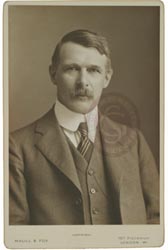Captain Lewis Moysey RAMC

|
|
Portrait of Dr Lewis Moysey, Maull & Fox, [1900s]. (GSL/POR/49/23-02) |
Fellowship details: No.4666, elected 4 December 1907.
Born: 1869
Died: 26 February 1918, aboard the hospital ship Glenart Castle, Bristol Channel.
Biography:
Lewis Moysey, younger son of John Moysey of Guilford, was born in 1869 and educated at Repton School and later at Caius College, Cambridge, where he studied medicine. He practised for many years in Nottingham, but in his spare time became interested in the fossils of the Coal Measures, spending whatever time he could searching for them and in preparing them for his cabinet. His general scientific knowledge led him to appreciate the relative importance of the specimens, so that anything rare or unusual was at once recognized as such, and brought to the notice of the proper specialist. Consequently Carboniferous palaeontology owes much to him, not only by reason of his own contributions to the literature, but also by the material which he made available for other workers. Many rarities were obtained by an ingenious method by which the refractory nodules containing the fossils were heated, soaked, and then alternately frozen and thawed until they cracked readily. One of his palaeontological papers was published in the Society’s Quarterly Journal for 1910, and others appeared in the Geological Magazine. He also contributed a comprehensive appendix on the fossils from the Derbyshire & Nottinghamshire Coalfield to the Geological Survey Memoir on the district (1913). He joined the Geological Society in 1907, and in 1915 a portion of the Lyell Fund was awarded to him in recognition of the value of his work. Shortly before his death, he presented the whole of his collection of fossil plants to the Sedgwick Museum, Cambridge, and the animal remains to the Museum of Practical Geology at Jermyn Street, London.
On the outbreak of war, he was called to the National Service, and was allotted regimental work in Britain until the final year of the war, when he was detailed for duty in the East. However he was killed before the start of the journey, drowning aboard the hospital ship ‘Glenart Castle’ when it was torpedoed in the Bristol Channel on 26 February 1918.
Memorial: Hollybrook Memorial, Southampton.
GSL awards: Lyell Fund, 9 February 1915. Awarded to Dr Lewis Moysey, as a mark of appreciation of his palaeontological work in the Derbyshire and Nottinghamshire Coalfields, and to stimulate him to further research.
Bibliography:
- Moysey, L, “On a Method of Splitting Ironstone Nodules by means of an Artificial Freezing Mixture”, ‘Geological Magazine’, Decade V, vol V (1908), pp220-222.
- Moysey, L, “On Palæoxyris and other Allied Fossils from the Derbyshire and Nottinghamshire Coalfield”, ‘Quarterly Journal of the Geological Society’, vol 66 (1910), pp329-344.
- Moysey, L, “On some Arthropod Remains from the Nottinghamshire and Derbyshire Coalfield”, ‘Geological Magazine’, Decade V, vol VIII (1911), pp497-507.
- Moysey, L, “On Some rare fossils from the Coal Measures of Nottinghamshire”, ‘Transactions… of the Nottingham Naturalists' Society, 1909-1910, (1911) pp41-43; ‘Report of the 80th Meeting of the British Association’, (1911), pp613-614.
- Moysey, L, “On the discovery of Anthrapalaemon in the Nottinghamshire coalfield”, ‘Transactions… of the Nottingham Naturalists' Society, 1910-1911, (1912) pp445-46.
- Moysey, L, “Some further Notes on Palaeoxryis and other Allied Fossils, with special reference to some New Features found in Vetacapsula”, ‘Report of the British Association, 1913, Birmingham’, (1914), pp492-493.
- Gibson, W, C B Wedd, J B Hill, G W Lamplugh, L Moysey, R L Sherlock, ‘The geology of the northern part of the Derbyshire Coalfield and bordering tracts…’, London: HMSO (1913).
- Obituary, ‘The Times’, 6 March 1918 & 9 March 1918.
- Obituary, ‘Geological Magazine’, New series, Decade VI, no.4 (1918), pp189-192.
- Obituary, ‘Quarterly Journal of the Geological Society’, vol 75 (1919), Proceedings pp lii-liii.
- Obituary, “Annual Report 1918”, ‘Proceedings of the Geologists’ Association’, vol 30 (1919), p95.